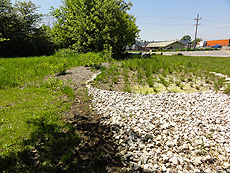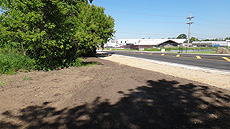Rain gardens for wildlife
 |
| Roads and Grounds recently built a rain garden by the Wilson Street entrance. Staff used on-site materials to stabilize the edges and planted native plants beyond the drainage outlet to absorb runoff. See below for the before photo. Photo: Richard Garcia, FESS |
Fermilab is working hard to stem the tide of on-site stormwater runoff contamination, which is a rising concern among environmental scientists. Both native plantings and effective roadside designs are essential tools we use to combat pollutants and reduce the amount of water entering storm sewers.
Stormwater contamination comes from vehicles and other urban developments, such as roofs, driveways, walkways, parking lots and compacted lawn areas, after a rain event.
As part of last year's upgrades to the laboratory security entrances, Roads and Grounds implemented a rain garden and vegetated swale at the Wilson Street entrance. A rain garden is usually a small, shallow depressed area that takes advantage of rainfall and runoff. It promotes water ponding rather than runoff. A vegetated swale is a gradual and broad sloping of the ground with plantings that encourage infiltration and proper conveyance of water.
The rain garden acts as an overflow catchment for the runoff passing through the swale and surrounding landscape. Together the systems collect rainwater and allow more to naturally percolate into the ground. This in turn allows the plants to absorb more water and to filter out most of the contaminants from the surface runoff, preventing the contaminants from making their way to our streams and rivers.
To avoid damaging the existing maple trees, we used rock to extend the drainage outlet beyond the trees so as not to disturb the roots.
We also selected native plants, mainly prairie grasses and wildflowers, that are able to adapt to the site conditions. They can take occasional flooding and can also survive periods of drought. They require less maintenance than typical lawn grass, and they add ecological benefits. Unlike foreign ornamental plants that have not adapted to the local ecosystem, native plants host beneficial insects and encourage wildlife to flourish in the area. Deep-rooted native plants allow for further infiltration into the soil.
Rain gardens can also be installed at home in places where water already collects, for example near downspouts coming off roofs. The garden becomes irrigated after rain events, cutting down on maintenance and removing the need for weekly mowing. It also supports habitat for birds and butterflies while providing an attractive landscape feature.
By selecting native plantings and combining them with a rain garden, you can have a positive effect on our delicate water resources and degrading wildlife habitat — one that is adaptable to our local climate.
—Richard Garcia
 |
| Before the rain garden construction: Roads and Grounds determined that this location by the Wilson Street entrance would be a good place for a rain garden based on its sunlit areas and water flow direction, as well as other site conditions. See above for the after photo. Photo: Richard Garcia |
|